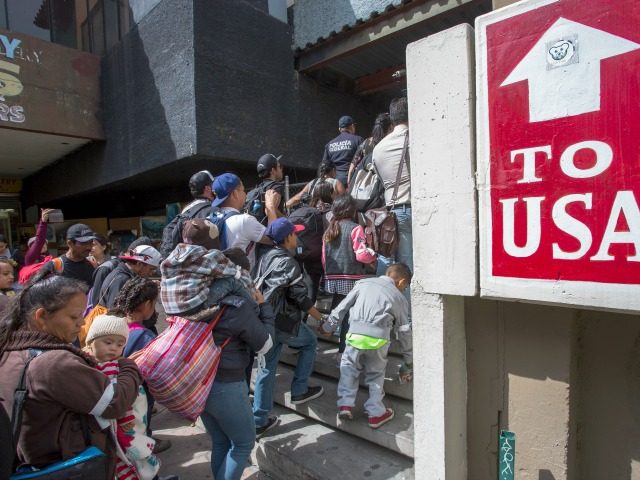United States border officers are limiting asylum applications from the Honduran migrant caravan to a few dozen people per day, so helping avoid a rush of migrants that would trigger “catch and release” policies.
On Sunday, the Customs and Border Protection announced they had taken their daily quota of asylum requests even before any of the migrants with the caravan asked permission to file for asylum. The note effectively told the caravan migrants they must get in line to ask permission to file for asylum.
The caravan’s roughly 300 would-be migrants intend to apply for asylum at the San Ysidro border station on Sunday, surrounded by sympathetic media and cheered on by supports on the Mexican and U.S. side of the see-through bollard wall.
But the border officers’ decision to limit the number of applicants per day will help them and the justice department’s immigration judges process requests to apply for asylum within the 20-days limit set by the 1997 Flores legal settlement.
The Flores settlement says the U.S. government cannot hold migrants with children for more than 20 days.
That means the border judges have 20 days to document the legal reasons for rejecting a request — or else let the migrants into the United States.
But if they can meet that deadline, the rejected migrants can be flown home without being allowed to file for asylum.
If they cannot meet that processing deadline, the migrants will be released into the United States and be allowed to file for asylum. Once released, the asylum-applicants can also get work permits, so allowing them to earn far more money in the United States than they could earn at home in Central America.
Since 2011, when former President Barack Obama was signaling his support for the migrants, that asylum process has been overwhelmed by a crush of migrants. The crush has created a backlog of roughly 700,000 asylum cases and a wait time of at least two years.
The symbolic clash between open-borders’ activists and the US. government’s border agencies prompted a rush of media coverage, most of it sympathetic to the migrants hoping to win the huge prize of U.S. residency.
Some supporters from the Mexican side climbed up the wall and cheered the migrants, but did not climb down o the U.S. side of the wall where they could be arrested for illegal entry.
Under existing laws, the migrants in the so-called ‘caravan’ can walk past border guards to ask officers and Justice Department immigration judges for permission to file asylum claims in federal courts.
That screening process is tightly governed by existing laws and court precedents, which require only that migrants show a “credible fear” of persecution should they be denied asylum. The low threshold ensures that border officers and immigration judges can only reject migrant requests if the asylum claims are very weak.
But most young men and women usually try to evade guards by sneaking or smuggling themselves over the border, via dangerous and expensive routes. The DHS memo targets them — and may deter some of the ‘caravan’ migrants from sneaking across this weekend.
In contrast, most of the people who ask for asylum are parents bringing their children from Central America. If their “credible fear” asylum claim is allowed, they will file an asylum claim and are released into the United States.
The asylum-seeking migrants are released into the United States for several reasons.
First, the immigration-court system has become backlogged since 2011 with more than 700,000 other asylum applications. The first available court dates can be two or three years in the future.
Second, Congress has funded only 40,520 detention spaces for migrants in 2018, ensuring there are no detention beds for most migrants. Most of the detention facilities are occupied by people who were caught trying to sneak across the border. The border jumpers are held until they are identified and processed, although some are also sent to jail.
Third, a 1997 court settlement, dubbed the Flores settlement, says officials cannot hold migrants with children for more than 20 days.
Once the asylum-seeking migrants and their children are released, they are also allowed to apply for work permits, and the children are allowed into schools in blue-collar neighborhoods.
Many migrants rationally use these “catch and release” loopholes to work legally in the United States for a few years, and many of those migrants also walk away from their asylum claims to work as illegal immigrants.
In 2017, the migration numbers dropped when Trump was elected. But the numbers are rising again because Democrats and business-first Republicans in Congress have refused to change the border laws or beef up border defenses. In fact, more than 100,000 migrants have used the asylum loopholes to walk through the walls since Trump was inaugurated.

COMMENTS
Please let us know if you're having issues with commenting.